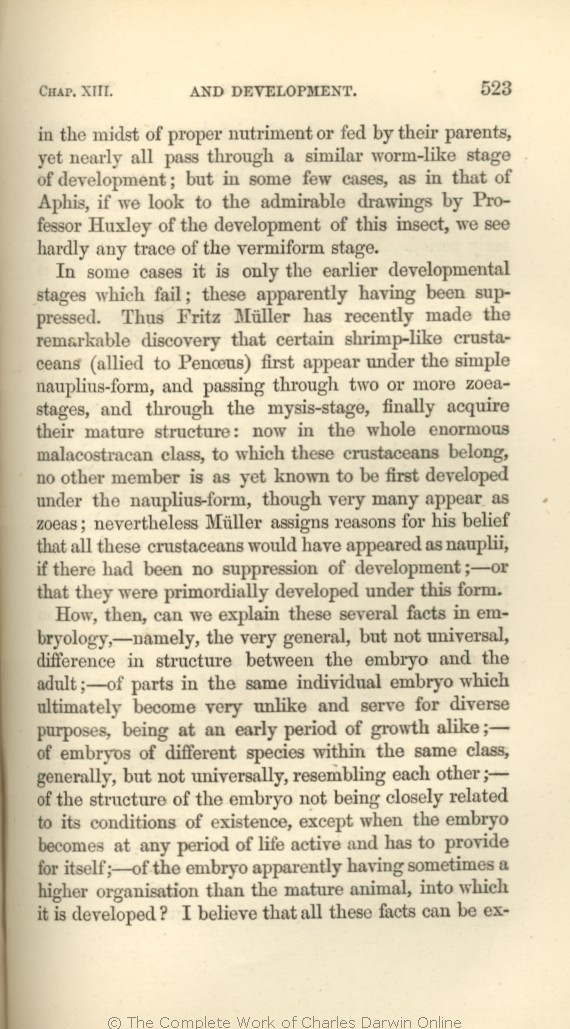In some cases | In some cases 1866 |
| Sometimes 1869 1872 |
| fail; 1866 | | fail. 1869 1872 |
| these 1866 | these 1869 1872 |
| apparently 1866 | apparently 1869 1872 |
| having 1866 | having 1869 1872 |
| suppressed. 1866 | suppressed. 1869 1872 |
| Müller 1866 1869 | | Müller 1872 |
| recently 1866 | recently 1869 1872 |
| passing 1866 | | after passing 1869 1872 |
| through the 1866 |
| then through the 1869 1872 |
| enormous 1866 | | great 1869 1872 |
| class, 1866 1869 | | order, 1872 |
| Müller 1866 1869 | | Müller 1872 |
| belief 1866 1869 | | belief, 1872 |
| these 1866 1869 | | there 1872 |
| crustaceans would have appeared as nauplii, if there 1866 1869 |
| OMIT 1872 |
| development;— or that they were primordially developed under this form. 1866 |
| development. 1869 |
| development, all these crustaceans would have appeared as nauplii. 1872 |
|
How, then, can we explain these several facts in embryology,—
namely, | namely, 1866 1869 1872 | | namely 1859 1860 1861 |
| but 1859 1860 1861 1866 | | though 1869 1872 |
| universal, 1866 1869 1872 | | universal 1859 1860 1861 |
| of 1859 1860 1861 1866 | | the various 1869 1872 |
| individual 1861 1866 1869 1872 | | indivividual 1859 1860 |
| embryo 1866 | | embryo, 1859 1860 1861 1869 1872 |
| an 1866 1869 1872 | | this 1859 1860 1861 |
| of embryos of different species within the same class, generally, 1859 1860 1861 1866 |
| the general, 1869 |
| the common, 1872 |
| universally, 1859 1860 1861 1866 | | invariable, 1869 1872 |
| resembling 1859 1860 1861 1866 | | resemblance 1869 1872 |
| each other;— 1859 1860 1861 1866 |
| between the embryos or larvæ 1869 1872 |
| structure of 1859 1860 1861 1866 |
| most distinct species in the same class;— 1869 1872 |
| not being closely related to its conditions of existence, existence, except when the embryo becomes at any period of life active and has 1866 |
| not being closely related to its conditions of existence, except when the embryo becomes at any period of life active and has 1859 1860 1861 |
| retaining whilst within the egg or womb, structures which are of no service to it, either at that period or later in life; whilst embryos at a later period, or larvæ, which have 1869 |
| often retaining whilst within the egg or womb, structures which are of no service to it, either at that or at a later period of life; on the other hand larvæ, which have 1872 |
| itself;— of the embryo apparently having sometimes a higher 1859 1860 1861 1866 |
| their own wants, are perfectly adapted to the surrounding conditions;— and lastly the fact of certain larvæ standing higher in the scale of 1869 |
| their own wants, being perfectly adapted to the surrounding conditions;— and lastly the fact of certain larvæ standing higher in the scale of 1872 |
| animal, 1859 1860 1861 1866 | | animals 1869 | | animal 1872 |
| it is 1859 1860 1861 1866 | | they are 1869 1872 |
| developed? 1860 1861 1866 1869 1872 | | developed. 1859 |
| ex- plained, 1866 | | explained, 1859 1860 1861 1869 1872 |
|









